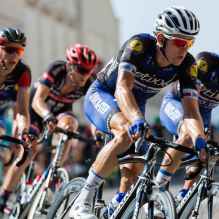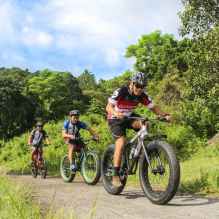
Regardless of your preferred cycling style, be it mountain biking, distance, or sprint if you’re spending a lot of time pedaling, it is very easy for the ratio of quadriceps to hamstring input in each pedal to get further and further out of whack. In a perfect world, you would have a near even input of force developing from your quadriceps and hamstrings into the pedal. If you’re thinking “how can you use an even amount of the hamstrings and quads, I thought they did opposite movements?“, you’re almost onto something. It is indeed true that the quads facilitate leg extension and the hamstrings facilitate lower-leg flexion, but we also need to be cognizant of the origin site for these muscles near the hip.
Some segments of the hamstrings and quadriceps are what we would call biarticular, meaning they work on two joints rather than just one. In the hamstrings these include the semitendinosus, semimembranosus, and the long head of the biceps femoris. In the quadriceps, the rectus femoris is a biarticular muscle that allows for hip flexion (raising the knee towards the navel) and also lower-leg extension.
When the ratio of hamstring to quadricep input is near its greatest, and pedal and seat placement are set up properly, you can unlock more power through the hips and knees as the bike and body work in synchrony.
"When the ratio of hamstring to quadricep input is near its greatest, and pedal and seat placement are set up properly, you can unlock more power through the hips and knees as the bike and body work in synchrony." TweetBut unfortunately the biomechanics of what is actually happening in the majority of cyclists isn’t nearly so neat and tidy. So getting to this point should be a primary goal of your training.
This near-even ratio is optimal for a handful of reasons, but I’ll focus on two major ones here:

First, a more even distribution of load across the hamstrings and quadriceps reduces fatigue. When there is a greater cross-section of muscle doing the same amount of work, the onset of fatigue is greatly reduced.
Secondly, consider the amount of rotations a cyclist will take over the course of even a relatively short, 10-mile ride. If the cyclist is using too much quadriceps, the likelihood of an overuse injury skyrockets. This is a very likely outcome; as a knee-dominant cycle becomes the norm, the body will rely more and more on knee extension throughout the cycle, leading to overdeveloped quads and ultimately to pain and injury.
You must go well out of your way to ensure this quad-dominant cycling strategy isn’t the norm. Since the majority of folks (athletes and sedentary desk-jockeys alike) are quad-dominant to begin with, you must actively seek out hamstring input. To make the hamstrings take more of the stress on the bike, you must:
a.) Practice reinforcing a more integrated cycling stride which is more cyclical than it is simply pushing down on the pedal
b.) Use traditional strengthening strategies to facilitate better hamstring activation
A skilled cycling instructor can help improve your cycle. Our scope of practice at Ruthless Performance relies much more on the latter. Hamstring strengthening exercises should develop both functions of the hamstrings. Various forms of leg curls should be implemented to improve and strengthen the hamstrings ability to achieve lower-leg flexion. And the equally important hip extension function of the hamstrings can be improved by regularly incorporating deadlift variations like rack pulls, Romanian Deadlifts, contralateral dumbbell deadlifts, and back (hip) extensions.
Training hip extension regularly as a cyclist will not only improve your performance on the bike, but it will also help strengthen your back. One of the issues surrounding cycling is the flexed (forwards) position of the spine. By incorporating hip extension exercises your back will be better situated in your day-to-day posture while simultaneously making the flexed spine position on the bike more comfortable.
Even though the quads will naturally takeover when cycling, a proactive approach to maximizing cycling performance through pattern reinforcement and strength training can fix this.
**Editor’s note: We plan on making the ‘Performance Enhancement Strategies for Cyclists’ a regular feature on the site. If you have any questions about cycling, we may be able to use them as a segment. To learn more about training with us or to submit a question, reach out on our contact page or email us at info@RuthlessPerformance.com.**
